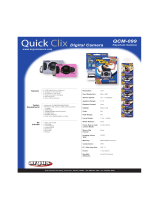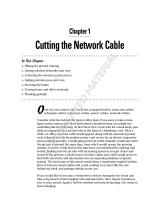Page is loading ...

About the
Power Mac G4 Cube
Includes setup and expansion information
for Power Mac G4 Cube computers

K Apple Computer, Inc.
© 2000 Apple Computer, Inc. All rights reserved.
Under the copyright laws, this manual may not be copied, in whole or in part, without the written consent of Apple.
The Apple logo is a trademark of Apple Computer, Inc., registered in the U.S. and other countries. Use of the
“keyboard” Apple logo (Option-Shift-K) for commercial purposes without the prior written consent of Apple may
constitute trademark infringement and unfair competition in violation of federal and state laws.
Every effort has been made to ensure that the information in this manual is accurate. Apple is not responsible for
printing or clerical errors.
Apple Computer, Inc.
1 Infinite Loop
Cupertino, CA 95014-2084
408-996-1010
http://www.apple.com
Apple, the Apple logo, AppleShare, AppleTalk, FireWire, the FireWire logo, Mac, Macintosh, the Mac logo,
Power Macintosh, and QuickTime are trademarks of Apple Computer, Inc., registered in the U.S. and other
countries.
AirPort, the Apple Store, Finder, iMovie, iTools, Power Mac, and Sherlock are trademarks of Apple Computer, Inc.
PowerPC and the Power PC logo are trademarks of International Business Machines Corporation, used under
license therefrom.
Manufactured under license from Dolby Laboratories. “Dolby” and the double-D symbol are trademarks of Dolby
Laboratories. Confidential Unpublished Works.
© 1992–1997 Dolby Laboratories, Inc. All rights reserved.
Other company and product names mentioned herein are trademarks of their respective companies. Mention of
third-party products is for informational purposes only and constitutes neither an endorsement nor a
recommendation. Apple assumes no responsibility with regard to the performance or use of these products.
Simultaneously published in the United States and Canada.

3
Contents
1 Setting Up 5
Positioning the Computer and Display 5
Setting Up Your Computer 6
Problems? 16
What’s Next? 17
2 Getting to Know Your Computer 19
Your Computer at a Glance 20
Your Computer’s Ports and Connectors 22
Inside Your Computer—Internal Expansion Options 24
QuickTime—Audio and Video on the Internet 26
Sherlock 2—Your Internet Search Detective 28
iMovie 2—Create and Edit Your Own Digital Movies 30
iTools—Free Internet Services for Mac Users 32
Auto Updating—Automatically Keep Your Mac on the Cutting Edge 34
Multiple Users—Turn One Mac Into Many 36
Apple.com—Your Starting Place on the World Wide Web 38
Mac Help—Answers to All Your Macintosh Questions 40
3 Using Your Computer 41
Using Your Apple Pro Keyboard and Apple Pro Mouse 42
Using Your Computer Speakers 44
Using USB Devices 46
Using FireWire Devices 48
Using Your DVD Drive 50
Using Your Modem 52

4 Contents
Connecting to an Ethernet Network 53
Using AirPort Wireless Networking 55
Putting the Computer to Sleep to Save Energy 56
Transferring Information Between Two Apple Computers 57
4Working Inside Your Computer 59
Removing the Computer Core 60
Installing Memory 64
Installing an AirPort Card 66
Replacing the Battery 67
Replacing the Computer Core in the Enclosure 68
5Troubleshooting 71
Appendix A
Specifications 75
Appendix B
Safety, Maintenance, and Ergonomics 81
Important Safety Information 81
General Maintenance 82
Important Ergonomic and Health-Related Information 83
Communications Regulation Information 85

5
CHAPTER
1
1
Setting Up
Congratulations on purchasing your new Power Mac G4 Cube—an elegant, compact, and
professional solution to desktop computing. This chapter contains instructions for setting up
your computer and display.
Positioning the Computer and Display
If your monitor is heavy, be sure to use correct lifting techniques when positioning it.
Position the computer and display so that
m they are on sturdy, flat surfaces
m nothing is on top of the computer or obstructs air flow through the top or rear of the
enclosure, or through the vents of the display
m the computer’s DVD disc drive is not obstructed
Important The only way to shut off power completely to your computer or display is to
disconnect their power plugs from the power source. Make sure the power cord for your
computer or display is within easy reach so that you can unplug it quickly if necessary.

6 Chapter 1
Setting Up Your Computer
Your computer ports and connectors are accessible from the bottom of the computer.
1 Carefully turn the computer upside-down and place it on a soft cloth.

Setting Up 7
2 Plug one end of the power cord into the power adapter.
Warning Use only the power adapter that came with your computer.
Power cord Don’t plug this end of the power cord
into the wall yet. You’ll do that later.
Power adapter

8 Chapter 1
3 Plug the power adapter plug into the power socket (marked with the icon ¯) on the bottom
of the computer.
Plug the power adapter
into the computer.
Power socket

Setting Up 9
4 Plug the other end of the power adapter cord into a grounded power outlet or power strip.
Grounded wall outlet

10 Chapter 1
5 Connect your monitor cables according to the following illustration:
If your monitor has an Apple Display Connector (ADC), connect it to the ADC port ( ).
You can bend the connector at an angle to fit underneath the computer.
Important Depending on your monitor, you may have one or more cables to connect.
Check the instructions that came with the monitor for further setup information.
ADC monitor port
VGA monitor port
™
Warning Be sure your computer is turned off before connecting your monitor. When
lifting the computer, be careful not to turn the computer on accidentally. Do not connect
or disconnect your monitor when the computer is turned on.

Setting Up 11
If your monitor has a VGA connector, attach the VGA-to-VGA adapter that came with your
computer to the VGA port and then connect your monitor cable to the adapter.
Plug the VGA adapter into
the VGA monitor port and
tighten the thumbscrews.
VGA monitor port
Plug the VGA monitor
cable into this end
of the adapter
and tighten the
thumbscrews.

12 Chapter 1
6 If required, connect your computer to your Ethernet network and connect your modem to a
phone line.
Ethernet port
Modem port
G
W

Setting Up 13
7 Tu rn your computer right side up.
Do not block the air flowing
through the opening in the
back of the computer.
Do not place anything
on top of the power button.
Do not put anything on
top of the computer. This
will block the air flowing
through the top vents.

14 Chapter 1
8 Connect the keyboard cable to a USB port on your monitor, and plug the mouse cable into a
USB port on the keyboard.
m If your monitor doesn’t have a USB port, connect the keyboard USB cable to a USB port
on the bottom of your computer.
If you wish, raise the keyboard by lifting it and flipping the foot toward the back.
USB ports
on bottom of
computer (2)
USB ports on display
USB ports on keyboard (2)

Setting Up 15
9 Connect your computer speakers.
m If you have an Apple Cinema Display or Apple Studio Display with an ADC connector,
connect your speakers to a USB port on the back of the display.
m If you have a different type of monitor, connect your speakers to a USB port on
the computer.
Important Your computer speakers have special power requirements that are supported
by the USB ports on your computer and by the USB ports on Apple displays that have the
ADC connector. Do not connect your speakers to other USB devices, such as your keyboard
or external USB hubs, which are not designed to support your speakers.
USB ports
on bottom of
computer
USB ports on display
Digital amplifier
SpeakerSpeaker

16 Chapter 1
10 Tu rn on your computer by touching the power button.
With some Apple monitors, you can also turn on the computer by pressing or touching the
monitor power button.
Problems?
If you don’t see anything on your screen or you think your computer did not start up
properly, check these items:
m Is the power adapter plugged into a power source? If it is plugged into a power strip, is
the power strip turned on? Is the power adapter properly plugged into the computer?
m Are the keyboard and monitor cables connected correctly?
m Is the power button lit on the computer and on the monitor? If not, the computer or
monitor aren’t receiving power. If the power button on your computer is pulsing, it means
the computer is in sleep. Touch the power button or any key to wake it up.
m Are the brightness and contrast controls on the monitor adjusted correctly? If your
monitor has brightness and contrast controls, try adjusting them.
m Tr y restarting your computer. Touch the power button on the computer for approximately
5 seconds until the computer turns off. Touch it again to turn the computer on.
m If you see a blinking question mark on the screen or a series of flashes from the
computer or display power buttons when you turn on the computer, see Chapter 5,
“Troubleshooting,” on page 71.
Power button

Setting Up 17
When You’re Finished Using Your Computer
To turn off your computer:
m Choose Shut Down from the Special menu.
Adjusting Your Monitor
Use the Monitors control panel to adjust the settings for your monitor. For information about
troubleshooting your display, see “Problems With Your Display” on page 73. For information
about maintaining your display, see “Maintaining Your Display” on page 83. Additional
information about using your monitor is available in Mac Help.
To register a new Apple Studio Display or Apple Cinema Display with Apple, go to the Apple
World Wide Web site: www.apple.com/register
What’s Next?
m For an overview of your computer’s features, see Chapter 2, “Getting to Know Your
Computer,” on page 19.
m For more information about using your modem, connecting to a network, or using the
computer’s other hardware features, see Chapter 3, “Using Your Computer,” on page 41.
m For information about installing memory, an AirPort wireless networking card, or
changing the computer’s battery, see Chapter 4, “Working Inside Your Computer,” on
page 59.
Important Do not turn off the computer by turning off the switch on a power strip or by
pulling the power adapter plug (unless you can’t turn off the computer any other way). Your
files or system software could be damaged if your computer is not shut down properly.


19
CHAPTER
2
2
Getting to Know Your Computer
If you’re eager to get started and want to try out a few things, this chapter is for you. It
provides an overview of your computer’s important hardware and software features.
Want to create your own video masterpieces? Take a look at iMovie and find out how you can
edit video on your computer. Learn how QuickTime can help you view live video broadcasts
from the World Wide Web. And take advantage of the Internet to research information,
update your software, shop, browse the Web for fun, or just get help when you need it.
Here you’ll find a great selection of your computer’s features presented and briefly
explained. Take a test run and see what your computer can do. For more information about a
specific feature, see Chapter 3, “Using Your Computer,” on page 41, and the online
explanations in Mac Help (see page 40).
Note: Pictures showing the latest software features may appear slightly different on your
screen.

20 Chapter 2
Your Computer at a Glance
Speaker
Power adapter
Power button
DVD disc drive
Digital amplifier Power button
Headphone jack Speaker
/



